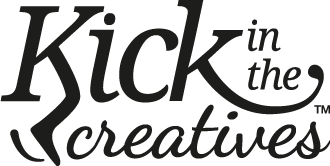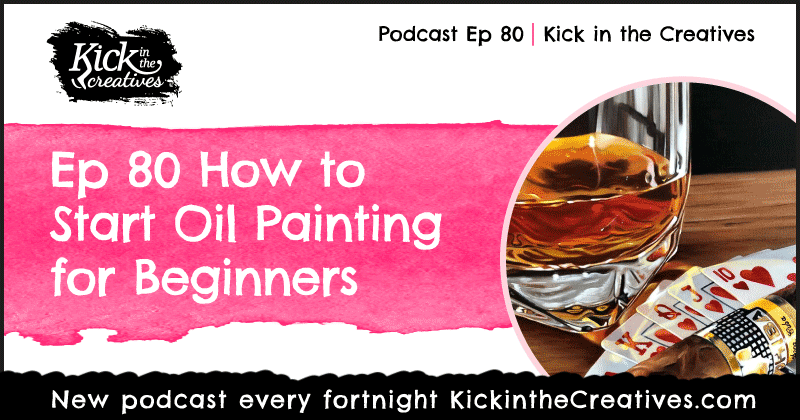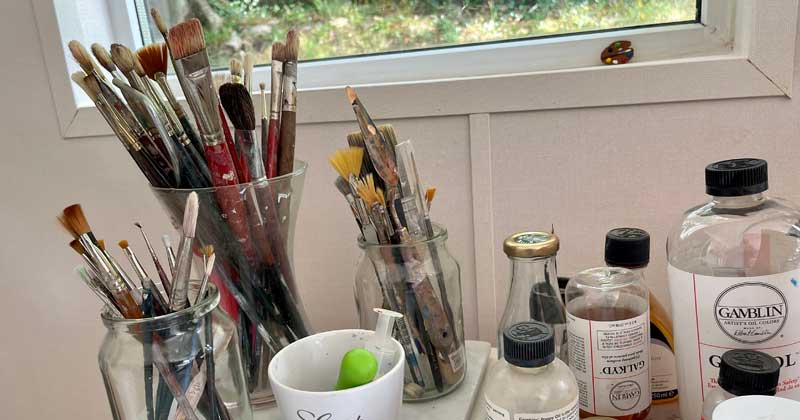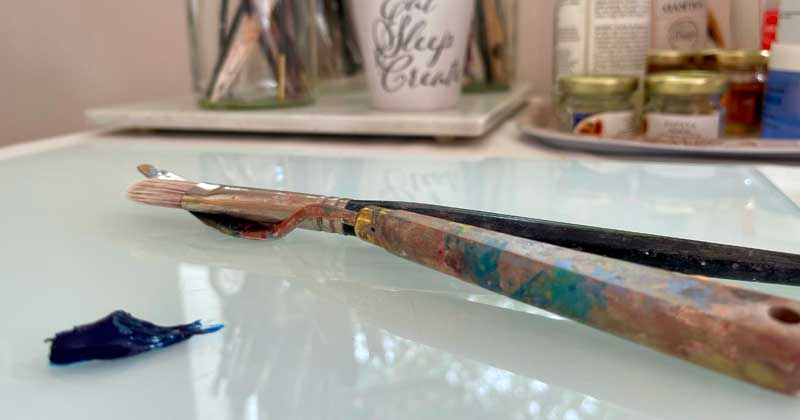Today we are talking about oil painting for beginners. Sandra remembers feeling scared to try them initially and so she talks from her own experience. She used to use watercolours because oil painting looked so complicated…. All those weird oil painting mediums, recipes, the expense, not to mention the health issues relating to oils and thinners that she had read about… And of course that unmistakable oil paint smell!
Subscribe: iTunes | Stitcher | Spotify | RSS
But about ten years ago an artist friend of hers said that she really should try them. At the time she didn’t feel that she had quite found her medium and she was still experimenting with everything but oil paints.
So, one day, she decided she would try them and it was an instant love affair. The moment she tried them, she knew she had found the perfect medium to suit her realism style.
What are the advantages of oil paint?
- Oil paints have a buttery consistency like no other
- They are very forgiving – far more so than watercolours
- Oils take longer to dry, giving you plenty of time to blend
- Oil paints are versatile. You can paint in thick impasto strokes or in thin layers
- Unlike watercolours, oils won’t fade. If they are used correctly an oil painting can last for hundreds of years
- You can paint in thick impasto strokes or in really thin layers – impasto just means paint applied really thickly, it looks like cake icing which has been applied by a knife and has texture
How did you learn oil painting?
I was a complete oil painting beginner and didn’t have anybody to tell me what I should be doing at that point. But once I tried oil paints, I really wanted to learn how to use them properly, because otherwise they might crack, or wrinkle over time. So I dedicated a lot of time to research and practice. I also started painting alongside Rosa Branson in her studio every now and then. It was great painting with her because she shared her tips, so I did have some support when I needed it.
Oil painting Rules
Fat over lean oil painting explanation
Fat, is simply referring to the percentage of oil content in your medium. Unless you are finishing a painting in one sitting, you would use slightly more oil with each progressive layer. This is to prevent the upper layers from drying more quickly than the under-layers.
Use a dark to light painting technique
Dark to light, simply means that you work from the darkest tones to your lightest, which is the complete opposite to what you would do with watercolours
Varnishing an Oil Painting
Don’t varnish an oil painting too quickly. Oil paintings can take anything up to a year to dry fully, depending on the thickness. Varnishing doesn’t allow the oil to dry underneath.
Mixing colours to make black
I don’t recommend using black from a tube because it is really flat and dull. Instead, try mixing your own black. I often start with ultramarine blue and then add a bit of burnt sienna until it becomes a rich black colour. Then if I want to change the character of that black, I might add a dab of alizarin crimson or another colour to push it slightly towards a warm or cool hue, depending on what I’m aiming for.

Sandra oil painting
Oil Painting Supplies for Beginners
Can you suggest an oil painting starter kit?
I would suggest a mid-range brand for a beginner. If you are just experimenting with oil paints, there’s no point in spending too much until you know you like them, unless you’re selling your work. Don’t go for a really cheap set from a budget shop either. You’re not going to get the full feel of what they’re like because they’re not strong pigments. I started with a Daler Rowney Georgian Oil set. You can get a starter set with basic colours which should last a long time unless you are painting with a palette knife.
A starter kit will usually include a white, a couple of Earth colours and a warm and cool version of each of the primaries.
Alternatively, you could start with just a white and an ultramarine blue, or an earth colour. This way you can create tonal paintings, just while you are trying to get the feel for them.
Non-smelly oil paint
I wouldn’t be painting with oils now if I used the smelly ones. They used to give me a headache. I just didn’t like it. I get cold really easily, so I’m not one to have all the windows open and that’s what you have to do if you’re using those stinky oils. I know I talk a lot about Gamblin (I am not affiliated with them in any way), but I love them, not just for their quality, but also they put so much into making their paints and medium safe. They don’t have those horrible fumes and the smells that are associated with other oils.
Non-odour thinners
There are plenty of non-odour thinners you can get, but it doesn’t mean that they’re not still evaporating into the air. So even though you can’t smell it, you could still be breathing it in. Gamblin thinner, which is called Gamsol is far less toxic because the smelly solvent has actually been removed. If you walked into my studio, you would never know that I wasn’t just using pencils, you just don’t smell anything and yet I’m an oil painter. I used to use the smelly ones when I first got started and it really put me off, I hated the smell.
What are the best brushes for oil painting?
Most people would start something like cheap hog hair brushes, but I never did like those. I prefer something more flexible, and more precise. Choosing brushes is trial and error depending on how much control you want.
I love Rosemary brushes. They’re slightly more expensive. I prefer brushes that are synthetic mix rather than just real hair. I think they’re more bouncy, more flexible and smoother. But if you’re painting impasto with lots of big bold strokes then you might go for a really big hog hair brush, and that might suit you better.
To get you started I’d go for a couple of round brushes and a couple of flat brushes, just mid-range, synthetic ones designed for acrylics or oils.
What about oil painting paper vs canvas?
Don’t make the mistake that I did and buy cheap oil painting paper to begin with. It comes in pads, but the problem is it buckles. If you’re going to use oil paints, you’re very rarely going to end up painting on oil paper anyway. So you’re better off buying a pack of really cheap cotton canvases from a budget shop. They’re absolutely fine to practice on until you’ve got used to the feel of the oils. Once you’ve got used to the paint, then you can buy better canvases and start experimenting with different surfaces.
Can you explain oil painting mediums?
You don’t have to use a medium at all. You can simply do the whole painting straight from the tube and that’s fine.
The reason you would use a medium is to speed up the drying time or slow it down further or alter the consistency to make it more transparent and inky.
I find oil paint straight from the tube is really stiff and I don’t like that, but some artists do.
Medium recipes can sound really complicated, but they don’t have to be. I make my own, but there are plenty of really good ready-made mediums out there. Gamblin oil paint mediums can slow down the oil painting drying time or speed it up. All you have to do is look it up on their website and it will tell you what they do. You don’t have to make your own medium at all. I only make my own because I like to use a particular oil.
There are so many brands of ready-made mediums. Windsor and Newton do a brand called Liquin. Gamblin do brands called Galkyd and Neo Megilp. You look at the names of them and that’s enough to make you think, “what is that?” They are literally just oil and thinners in various proportions with different types of oil. And that’s it. The great thing about the Gamblin ones is that they don’t smell.
I know some artists such as Rosa Branson just use a tiny bit of linseed oil on its own in very small amounts. Linseed oil is already found in your paint. What you have to remember when you’re doing that is if you use too much oil without any thinners you can end up with problems. I don’t like linseed oil at all because I hate the smell. It can also be flammable if disposed of improperly.
What’s the best palette for oil painting?
I started with a tear-off paper palette when I started painting with oils. That’s great for beginners just trying them out. But if you were to always use those it would end up expensive and wasteful. I then had a glass palette made. It’s a large bit of toughened glass with polished edges. It has been sprayed white underneath. I went to a Glazier and asked them to make one for me. It’s really easy to scrape off the dry paint, even if you’ve left it for a couple of days. Ideally, you wipe it off at the end of every session, but if it happens to dry out, just get a flat blade and put a bit of soapy water onto the pile of dry paint. Use the flat edge of the blade to scrape it off.
I’ve had mine for a few years now. I’ve never needed anything else and it still looks like a fresh new piece of glass. It was £70 to have it made, so fairly expensive, but it will last a long time.
Do you need an artist’s easel?
You can work flat, but I don’t because it’s harder not to smudge your painting. I use a big easel when I’m painting large paintings and a tilted table easel for my smaller ones. I don’t like painting completely flat, but it’s down to personal preference.
Using a Mahl Stick
A Mahl stick is a long stick with a leather ball on the end. You can use it to rest your painting hand against instead of smudging your painting. For instance, if I’ve got my big painting on my easel and I want to do something in the middle of it, I don’t want to rest my hand on the painting in case I smudge it. What I do is I put the leather ball on the very edge of the canvas and hold the other end with my other hand. Then I can use it to rest the palm of my hand so I can get anywhere in the painting. It’s great.
Cleaning up after oil painting
Cleaning your hands after oil painting
I use baby wipes regularly to clean my hands and the handles of my brushes occasionally.
How to clean oil paint brushes without paint thinner
I wipe my brushes on a rag and then I put some Murphy’s oil soap in my hand. Then I massage the ends of the brushes into the palm of my hand and rinse them out, so it’s not that difficult. I used to use thinners to do it but they wreck your brushes and it’s expensive to do it that way. The oil soap is much safer, it doesn’t smell and it protects your brushes.
Do you draw in pencil outlines before you paint?
If it’s a really simple thing I’ll use a very thin bit of acrylic paint in an earth colour just to get the basic lines down. You can paint over that and they don’t disappear. If you do it with oil paints you’ve got to wait for that to dry before you can go over it. If I’m doing a large or complicated painting I’ll always do a pencil drawing first.
Acrylic vs oil paint
I don’t like acrylics at all because they dry very quickly. You can put retarder in them, but they still dry way quicker than my oil paints. It doesn’t give me the blending time that I like. What I do love about acrylics is they do amazing neon colours that I’ve never seen in oils.
Water mixable oil paint
I tested water-soluble oil paints because I hated the smell of normal oils. I think they were a Van Gogh brand. They seemed chalkier and not as transparent. They didn’t have that same buttery feel that normal oil paints have, so I just didn’t like them as much.
I gave mine to artist Crystal Cook, she’s a watercolour artist whose work is incredible. She wanted to try out oil paints but was worried about the mess. She painted some gorgeous paintings with them. They suited her perfectly. They just didn’t suit me.
Is oil painting expensive?
I guess that depends on how you use them. If you work in those big bold impasto strokes with a palette knife, that’s going to use a lot of paint in one sitting. That’s going to be expensive. I use thin layers and so a tube of paint lasts me months. So it’s really hard to compare with other mediums for that reason.
Online oil painting classes
Learn realistic oil painting techniques with Evolve
If you want to learn oil painting, first, I would recommend you try out oil paints in the way we’ve suggested to make sure they are right for you. If you are serious about wanting to learn how to use oils to a high level to create realistic paintings, I would recommend the Evolve Online Oil Painting Programme.
Evolve is a platform that can teach anyone how to paint in a realism style in a year or less. You can check out their mini-course by going to https://kickinthecreatives.com/EvolveMiniCourse
If you want to know more about Evolve, go back and listen to Episode 73 with artist Kevin Murphy,
To learn to paint in a loose oil painting style
For a more loose style of oil painting, we also mention Carol Marine – we haven’t tried her tutorials but she paints quickly with oils and has a website where people create daily paintings
Please note that this post includes affiliate links. This means that if you purchase something via our link, we will get a commission, which helps us towards the cost of running Kick in the Creatives, and it doesn’t cost you a penny more. Thank you so much for your support.
This week’s creative question
Q. What type of art or mediums have you always wanted to try but haven’t? Why is that?
The best answers will be read out on a future podcast.
You can Tweet us your answers @KickCreatives or let us know in the Facebook Group, which by the way if you haven’t already joined, I highly recommend that you do! We will put the question up there and also on the facebook page… and of course, on our Instagram page @kickinthecreatives.
If you have any suggestions for the podcast or our challenges please feel free to get in touch.
.
Subscribe to our Youtube channel and click the notifications bell to be alerted on all our new videos.










